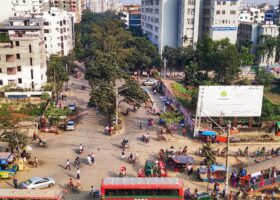Delhi behind afforestation spending, but fares well in greening: Report – Hindustan Times

Report on Delhi’s Afforestation Fund Utilisation and its Implications for Sustainable Development Goals
1.0 Executive Summary
- This report analyses the utilisation of Delhi’s Compensatory Afforestation Fund Management and Planning Authority (CAMPA) funds for the period 2019-2024, based on findings from the Central Empowered Committee (CEC).
- It highlights a significant disparity between allocated funds and actual expenditure, positioning Delhi as the lowest in fund utilisation nationally.
- Despite financial shortcomings, the report notes commendable performance in achieving physical afforestation targets, directly contributing to key Sustainable Development Goals (SDGs).
- The analysis underscores how administrative inefficiencies impede progress towards SDG 15 (Life on Land), SDG 11 (Sustainable Cities and Communities), SDG 13 (Climate Action), and SDG 16 (Peace, Justice and Strong Institutions).
2.0 Financial Performance and Fund Utilisation
2.1 Overview of CAMPA Funds (FY 2019-24)
- Total Approved Outlay: ₹116.78 crore was approved by the National Authority for Delhi CAMPA.
- Funds Released: The Delhi Administration released ₹93.06 crore, representing 79.69% of the approved amount.
- Funds Utilised: Only ₹25 crore was spent, equating to a utilisation rate of just 26.90% of the released funds.
2.2 National Comparison and SDG Impact
- Delhi’s 26.90% utilisation rate is the lowest among all states and Union Territories.
- This contrasts sharply with states like Andhra Pradesh (100%), Arunachal Pradesh (97.7%), and Karnataka (96.5%).
- Such low expenditure directly hinders the scaling of projects essential for achieving urban environmental targets outlined in SDG 11 (Sustainable Cities and Communities) and climate mitigation efforts under SDG 13 (Climate Action).
3.0 Physical Afforestation Performance and SDG Alignment
3.1 Greening Targets and Achievements
- Afforestation Target: The National CAMPA mandated afforestation across 190.91 hectares.
- Afforestation Achieved: Delhi successfully carried out afforestation on 179.96 hectares, meeting the majority of its physical target.
- Project Sustainability: A third-party audit in 2020-21 confirmed a high sapling survival rate of 91%, indicating effective on-ground implementation.
3.2 Contribution to Sustainable Development Goals
- SDG 15 (Life on Land): The successful greening of nearly 180 hectares and the high survival rate of saplings make a direct and positive contribution to protecting and restoring terrestrial ecosystems within an urban landscape.
- SDG 11 (Sustainable Cities and Communities): These afforestation activities enhance Delhi’s green public spaces, improving urban biodiversity and the quality of life for its residents.
- SDG 13 (Climate Action): By expanding its green cover, Delhi is actively strengthening its capacity for carbon sequestration, a critical action for mitigating climate change.
4.0 Governance and Administrative Challenges
4.1 Institutional Deficiencies
- Governance Oversight: The Delhi CAMPA’s governing body failed to convene a single meeting between 2018-19 and 2024-25.
- Financial Accountability: Annual financial accounts have not been prepared since 2018-19, preventing a mandatory audit by the Comptroller and Auditor General (C&AG).
- Operational Structure: The authority operates without a dedicated office or specialized team to manage its affairs.
- Administrative Delays: Committee members cite significant delays in administrative approvals and challenges in identifying land as primary reasons for low fund expenditure.
4.2 Implications for SDG 16 (Peace, Justice and Strong Institutions)
- The identified issues—lack of meetings, delayed financial reporting, and administrative bottlenecks—point to a failure in establishing effective, accountable, and transparent institutions as mandated by SDG Target 16.6.
- These governance failures are the root cause of fund underutilisation, creating a significant barrier to achieving the environmental objectives of SDGs 11, 13, and 15.
5.0 Conclusion
The case of Delhi’s CAMPA funds presents a paradox: successful on-ground afforestation coexists with severe financial mismanagement and administrative paralysis. While physical targets contributing to SDG 15 (Life on Land) are largely being met, the failure to utilise nearly 75% of available funds highlights a critical governance deficit. Addressing these institutional weaknesses is paramount for Delhi to fully leverage its resources and make comprehensive progress on its sustainable development agenda.
Analysis of Sustainable Development Goals (SDGs) in the Article
1. Which SDGs are addressed or connected to the issues highlighted in the article?
The article on Delhi’s afforestation efforts and fund management touches upon several Sustainable Development Goals (SDGs). The primary goals identified are:
- SDG 15: Life on Land: This is the most directly relevant SDG, as the article’s core subject is “compensatory afforestation,” “greening,” and managing forest land to compensate for areas diverted for other uses. It deals with protecting, restoring, and promoting the sustainable use of terrestrial ecosystems.
- SDG 11: Sustainable Cities and Communities: The context of the article is Delhi, a major urban area. The “greening” initiatives and afforestation efforts contribute directly to making the city more sustainable, improving the urban environment, and providing green spaces for its inhabitants.
- SDG 17: Partnerships for the Goals: This goal is relevant due to the article’s focus on the financial and institutional mechanisms for achieving environmental targets. It highlights the challenges in fund utilization (CAMPA funds), governance (lack of meetings, pending audits), and the roles of various bodies like the Central Empowered Committee (CEC), National CAMPA, and state authorities, which are all part of the implementation framework.
2. What specific targets under those SDGs can be identified based on the article’s content?
Based on the issues discussed, the following specific targets can be identified:
-
SDG 15: Life on Land
- Target 15.1: “By 2020, ensure the conservation, restoration and sustainable use of terrestrial and inland freshwater ecosystems and their services, in particular forests…” The article’s entire premise of “compensatory afforestation” is a mechanism to restore forest cover lost to non-forestry activities, directly aligning with this target.
- Target 15.2: “By 2020, promote the implementation of sustainable management of all types of forests, halt deforestation, restore degraded forests and substantially increase afforestation and reforestation globally.” The article explicitly discusses Delhi’s afforestation targets and achievements (“National CAMPA required 190.91 hectares to be covered, with Delhi having carried out afforestation across 179.96 hectares”).
-
SDG 11: Sustainable Cities and Communities
- Target 11.7: “By 2030, provide universal access to safe, inclusive and accessible, green and public spaces…” The report’s finding that Delhi “has fared well in terms of greening through afforestation” directly contributes to this target by increasing the green cover within the urban landscape of Delhi.
-
SDG 17: Partnerships for the Goals
- Target 17.1: “Strengthen domestic resource mobilization… to improve domestic capacity for tax and other revenue collection.” The Compensatory Afforestation Fund Management and Planning Authority (CAMPA) fund is a specific domestic financial resource mobilized for environmental conservation. The article’s focus on the poor utilization of these funds (“spent just over ₹25 crore out of ₹116.78 crore allocated”) highlights challenges in the effective use of mobilized domestic resources.
- Target 17.16: “Enhance the global partnership for sustainable development, complemented by multi-stakeholder partnerships…” The article describes a multi-stakeholder framework involving the Supreme Court-appointed Central Empowered Committee (CEC), the National CAMPA, the Delhi state CAMPA authority, and the Forest Research Institute (FRI) for third-party monitoring. The challenges mentioned, such as the governing body failing to hold meetings, point to weaknesses within this partnership.
3. Are there any indicators mentioned or implied in the article that can be used to measure progress towards the identified targets?
Yes, the article provides several quantitative and qualitative indicators that can be used to measure progress:
- Indicator for SDG 15 (Progress in Afforestation): The article provides direct data on the area of land afforested.
- Physical Target vs. Achievement: “The National CAMPA required 190.91 hectares to be covered, with Delhi having carried out afforestation across 179.96 hectares.” This serves as a direct indicator for Target 15.2.
- Survival Rate of Saplings: “an audit last took place in 2020-21, with 91% of the saplings surviving.” This is a crucial qualitative indicator of the effectiveness of afforestation efforts.
- Indicator for SDG 17 (Financial Management and Efficiency): The article is rich with financial data that serves as an indicator for the efficiency of domestic resource utilization (Target 17.1).
- Fund Allocation and Utilization: Delhi spent “₹25 crore out of ₹116.78 crore allocated between 2019-20 and 2023-24.”
- Fund Utilization Rate: The utilization rate for Delhi is explicitly stated as “26.90% of the released funds,” which is described as the “lowest utilisation percentage among all states and UTs.” This is a direct performance indicator.
- Indicator for SDG 17 (Institutional Effectiveness and Governance): The article implies several indicators for measuring the strength and effectiveness of the institutional framework (Target 17.16).
- Frequency of Governance Meetings: “the governing body for the Delhi authority had failed to hold a single meeting between 2018-19 and 2024-25.” This indicates a severe governance gap.
- Institutional Capacity: “The Delhi Authority does not have a separate office or team to manage affairs of the Delhi CAMPA.” This points to a lack of dedicated institutional capacity.
- Accountability and Auditing: The fact that “annual accounts for the Delhi CAMPA since 2018-19 were under preparation, and a C&AG audit will be conducted once these documents are ready” indicates a lag in financial accountability.
4. Table of SDGs, Targets, and Indicators
| SDGs | Targets | Indicators Identified in the Article |
|---|---|---|
| SDG 15: Life on Land | 15.2: Promote sustainable management of all types of forests, halt deforestation, restore degraded forests and substantially increase afforestation. |
|
| SDG 11: Sustainable Cities and Communities | 11.7: Provide universal access to safe, inclusive and accessible, green and public spaces. |
|
| SDG 17: Partnerships for the Goals | 17.1: Strengthen domestic resource mobilization. |
|
| SDG 17: Partnerships for the Goals | 17.16: Enhance multi-stakeholder partnerships. |
|
Source: hindustantimes.com

What is Your Reaction?
 Like
0
Like
0
 Dislike
0
Dislike
0
 Love
0
Love
0
 Funny
0
Funny
0
 Angry
0
Angry
0
 Sad
0
Sad
0
 Wow
0
Wow
0







































































